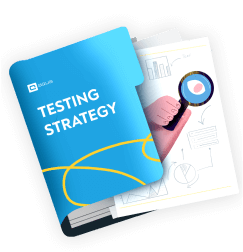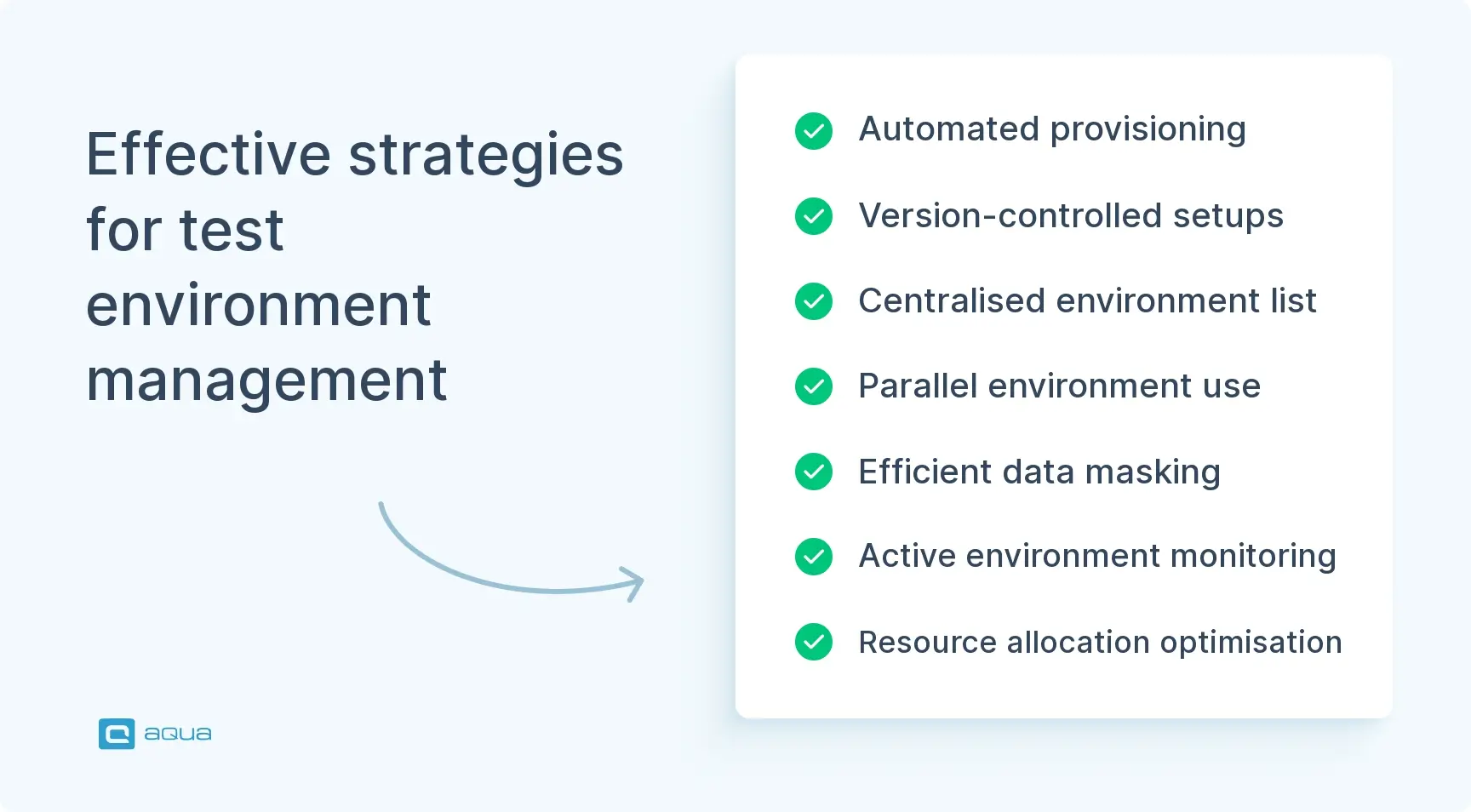This advanced guide delves into test environment management, unravelling the intricacies beyond the basics. Get ready to unlock the secrets of optimising, streamlining, and harmonising your testing environments as we equip you with the knowledge and strategies needed to navigate the challenges of today’s dynamic testing landscape.
What are test environments?
The test environment is the controlled setup or conditions in which you conduct software testing. They mimic the real-world systems, configurations, and interactions that the software will encounter when deployed.
Test environments are crucial for verifying software applications’ functionality, performance, and reliability before you release them to users. Various components such as hardware, software, networks, databases, and external systems are replicated in a test environment to simulate the production environment. This allows you to identify and rectify issues, assess system behaviour, and validate that the software meets the specified requirements.
Types of Testing Environments
Testing environments come in various forms, each validating specific aspects of software functionality, performance, or security. Every type of environment creates a controlled setting that simulates conditions the application will encounter, allowing you to catch potential issues at different stages. Here’s a breakdown of the main types:
1. Development Environment
Although it is not a specific environment of testing, the development environment is where you usually carry out component and unit testing. This environment allows developers to verify code at a granular level. They ensure each function or module behaves as expected before it’s integrated with others. It’s an agile, flexible setup that focuses on catching issues early in the coding process.
2. System Testing Environment
The system environment for testing is designed for end-to-end testing of the entire application. In this setting, all modules and components come together, mimicking the structure of the production environment. As QA, you perform functional testing, validating whether each part works cohesively as a whole. In this environment, you identify integration issues and confirm that the system meets all requirements.
3. Performance Testing Environment
For performance testing, an environment is set up to evaluate the software’s speed, stability, and scalability under load. Simulating high-traffic scenarios and different levels of demand, this environment helps you observe how the application behaves under stress. This includes:
- Load testing
- Stress testing
- Endurance testing
These three ensure the software can handle real-world traffic and usage.
4. UAT (User Acceptance Testing) Environment
The UAT environment is a staging area for user acceptance testing, typically involving real users or stakeholders. In this environment, you mimic the production environment closely, allowing users to interact with the application. Then they provide feedback on its functionality and usability. It’s a final check to ensure the software meets business and user needs before it goes live.
5. Security Testing Environment
The last one on the list – security testing requires a dedicated environment to ensure application safety against vulnerabilities, breaches, or attacks. You simulate various threats to evaluate how robust your security measures are. By isolating this environment, you protect sensitive data and configurations while you conduct comprehensive security checks.
Each of these environments brings value by isolating and examining specific application aspects. They help you ensure a stable, secure, and user-ready software product upon release.
Role of test environments in different testing stages
Test environment management process is critical in various stages of the software testing lifecycle, ensuring software applications are thoroughly evaluated and validated before the release. This is how test environments are used in different testing phases:
- Unit testing: In unit testing, you test software’s components or modules in isolation. Test environments provide a controlled setup where developers can assess these components’ functionality. Isolating the unit under test helps with early defect identification and efficient debugging.
- Performance testing: Performance testing assesses the software’s responsiveness, stability, and scalability under different conditions. Test environments stress the system to identify bottlenecks and performance issues. Accurate test environments are essential for obtaining reliable performance metrics.
- Security testing: Security testing aims to identify vulnerabilities and weaknesses in security mechanisms. Test environments should simulate potential threats and security breaches, allowing testers to assess the effectiveness of security measures in a controlled setting.
- Integration testing: Integration testing focuses on interactions between different units/modules. Test environments simulate the interactions between these components to ensure that they work well together. By replicating real-world scenarios, integration testing in a controlled environment detects integration issues and verifies data flow between various software parts.
- System testing: System testing evaluates the entire software system. Test environments for system testing mirror the intended production environment as closely as possible. This stage ensures the software functions properly when all components are integrated, including third-party systems, databases, networks, and interfaces.
- Regression testing: Regression testing verifies that changes or updates do not adversely affect software’s existing functionalities. Test environments ensure that the software behaves consistently across different iterations and that any new features or fixes are appropriately integrated.
- Compatibility testing: Compatibility testing ensures the software functions correctly on different platforms, browsers, devices, and operating systems. Test environments for compatibility testing encompass various configurations to replicate various user setups.
- User acceptance testing (UAT): UAT validates whether the software meets the business requirements and user expectations. In UAT, test environments should closely resemble the production environment to provide end-users with a realistic experience, ensuring the software aligns with user needs and whether it needs final adjustments before release.
Knowing when to stop testing is crucial in environment management to ensure efficient resource allocation and timely project delivery. Once the defined test cases have been executed, the environment has been thoroughly validated, and critical defects have been addressed, the testing phase can be considered complete.
Common challenges in test environment management
Agile test environment management is complex and challenging, especially in large and dynamic software development projects. Here are some common challenges you might face when managing test environments:
- Configuration drift: It occurs when the test environment settings and configurations gradually deviate from the intended state. The drift results in inconsistent test results, making reproducing defects challenging. Configuration drift requires strict version control, automated provisioning, and regular audits to ensure that environments remain consistent.
- Lack of resources: Test environments require hardware, software licenses, databases, and network resources. Limited availability of these resources can lead to testing delays and impact project timelines. You must optimise resource allocation, invest in virtualisation or cloud solutions, and establish resource-sharing practices to address this challenge.
- Inefficient scheduling: Scheduling test environments among teams and other stakeholders can be complex. Conflicting demands and poor scheduling can result in resource bottlenecks and delays. Implementing a centralised scheduling system, clear communication protocols, and automated provisioning will help with this challenge.
- Data management: Test environments require specific datasets to simulate real-world scenarios accurately, which can be challenging to manage, refresh, and mask. You need robust data management strategies, data masking tools, and data privacy compliance measures to ensure data integrity and security.
- Environmental dependencies: Modern software systems often rely on various external services, APIs, and integrations. Coordinating these dependencies within test environments is an error-prone, complex process. You must establish mock services, simulate external interactions, or create dedicated environments for testing dependent components.
- Environment provisioning delays: Those manual provisioning headaches that drag your testing cycles? Here’s the thing: switching to Infrastructure as Code tools like Terraform can cut your environment spin-up times from hours to minutes.
Start with one simple self-service portal for your most-requested test configs. You’ll dodge the common trap of over-engineering by keeping it basic initially. Track your “request-to-ready” time as your key metric. - Testing data consistency: Ensuring consistent test data across different environments is crucial for reliable testing. Discrepancies in data can lead to inaccurate test results and difficulties reproducing defects. You need strategies for maintaining data consistency, such as data synchronisation scripts or data migration tools.
- Maintaining parallel environments: Different testing phases may require parallel environments with specific configurations and data. Managing and coordinating these parallel environments can become complex and resource-intensive. Implementing version-controlled environment templates and leveraging automation can help maintain parallel environments efficiently.
- Environment stability: Frequent changes to the test environment, such as updates, patches, or configuration changes, can introduce instability and affect testing outcomes. Organisations need a balance between maintaining a stable environment and accommodating necessary changes. Version control, change management processes, and automated testing can mitigate this challenge.

Software testing is full of uncertainties, and who would say no to a masterfully crafted, free resource? Well, you shouldn’t. We have meticulously created a testing strategy template to be your candle in the dark, helping you navigate complex challenges in this ever-growing industry. You should say goodbye to old-fashioned approaches and start unlocking the full potential of your software development. This template is just 2-3 clicks away from paving the way for impeccable software quality.

Get the only testing strategy template you need for FREE
Strategies and tactics for effective test environment management
There are some test environment best practices to ensure seamless software testing and delivery, including the following:
- Automated provisioning: Implement automation tools to quickly and consistently set up and tear down test environments. With Infrastructure as Code (IaC) tools like Terraform or Docker containers, you can create reproducible environments, reducing manual errors and provisioning time.
- Environment version control: Treat test environment management like code using version control systems to ensure well-documented environments, changes are tracked, and you can easily roll back to previous configurations if needed.
- Centralised environment catalogue: Maintain a catalogue of different test environments, including their configurations, dependencies, and data. This helps testers and developers quickly identify and select the appropriate environment for their testing needs.
- Configuration management: Use configuration management tools to manage and enforce consistent configurations across different environments. This prevents configuration drift and ensures that environments accurately represent the production environment.
- Parallel environments: Establish parallel environments that mirror production environment. This allows multiple testing phases (like integration, system, and UAT) to run concurrently without impacting each other, optimising testing throughput.
- Data management and masking: Implement strategies to manage test data effectively. Use data masking techniques to secure sensitive data while providing realistic test scenarios.
- Collaboration and communication: Foster collaboration between development, testing, and operations teams. Clear communication channels and a shared understanding of environmental requirements are crucial for avoiding conflicts and delays.
- Environment monitoring: Implement monitoring tools to track the health and performance of test environments. This helps identify issues early and ensure that environments remain stable during testing.
- Resource optimisation: Allocate resources efficiently using virtualisation and cloud technologies. Scale resources up or down based on testing needs, reducing resource constraints and costs.
- Scheduled refreshes: You’ll want to automate your environment refreshes every sprint. But you need to tie those updates directly to your main branch commits. Set up a simple trigger that kicks off when code hits production, then watch your test accuracy nearly double. Start by scripting just the database refresh first; you can always layer in configuration updates later. Environments that sync overnight, so your team never wastes morning standup time debugging stale data issues.
- Test data generation: Automate test data generation with AI testing to create realistic testing scenarios. This is especially useful for performance, scalability, and stress testing.
- Disaster recovery testing: Periodically test disaster recovery scenarios in isolated environments to ensure the software can recover and function correctly in case of system failures.
- Documentation and training: Document your test environment management processes and provide training for team members. This ensures consistency and knowledge sharing and enables new team members to understand the environment setup quickly.
- Continuous improvement: Regularly review and refine your test environment management processes. Solicit feedback from teams and stakeholders to identify areas for improvement and adapt to evolving project needs.

By implementing these best practices, you can achieve a well-organised, efficient, and reliable process, leading to improved overall project outcomes.
The Rise of Self-Service and On-Demand Environments
You need to ditch the old ‘submit a ticket and wait’ approach for something way more efficient: self-service environment provisioning. You can now spin up your own testing environments through user-friendly portals or automation pipelines, which cuts out those frustrating delays that used to kill momentum.
Here’s what makes this approach so powerful: these platforms hook directly into Infrastructure as Code (IaC) and container systems. This means you get instant, production-like environments for each feature or test cycle without having to poke around asking for permissions.
Start small by identifying your most requested environment type – maybe it’s your standard API testing setup. Build that template first and let teams provision it on demand. Organisations using this approach report deployment delays dropping by nearly 60%.
The surprising bit? This actually strengthens security rather than weakening it. When everything’s templated and automated, you get consistent governance baked right in. Your developers get the autonomy they need, QA teams stop waiting around, and your ops folks can focus on bigger challenges instead of constant environment babysitting.
How to manage test environments and allocate resources for testing?
Resource allocation is pivotal to ensuring the integrity and efficiency of software testing processes, and it requires an adequate test environment management plan. This involves maintaining a well-documented catalogue of test environment management where each type is defined by its configurations, dependencies, and intended use. A comprehensive inventory of available resources, including hardware, software licenses, and databases, helps plan strategic resource allocation.
To optimise resource distribution, leveraging virtualisation and cloud technologies enables flexible scaling according to testing demands. Furthermore, implementing automated provisioning streamlines environment setup, reduces errors and enhances consistency. Centralised scheduling systems synchronise testing activities, preventing resource conflicts and bottlenecks. Crucially, fostering cross-functional collaboration between testing, development, and operations teams ensures transparent communication regarding resource requirements, allowing for efficient allocation. Regular reviews and iterative adjustments refine the resource allocation process, aligning it with project priorities and timelines.
Tools and technologies for test environment management
Test environment management (TEM) uses various technologies to create, manage, and maintain testing environments. These technologies ensure consistent and accurate test setups throughout the development lifecycle. Some key technologies used for test environment management include:
- Virtualisation: Virtualisation technologies like VMware, VirtualBox, and Hyper-V enable the creation of virtual machines that mimic physical hardware environments. This allows for isolation, replication, and easy sharing of test environments.
- Containerisation: Docker and Kubernetes provide lightweight, isolated environments that encapsulate applications and dependencies. Containers offer consistent environments for testing across different stages of development.
- Cloud computing: Cloud platforms like AWS, Azure, and Google Cloud provision on-demand infrastructure. They offer scalable resources for creating and managing test environments without physical hardware.
- Version control systems: Tools like Git or SVN help manage and track changes to environment configurations, ensuring consistency and traceability.
- Infrastructure as Code (IaC): IaC tools like Terraform and CloudFormation allow you to define and provision infrastructure using code. This ensures consistent, version-controlled, and automated environment setup.
- Configuration management: Tools like Ansible, Puppet, and Chef automate the configuration and management of software and infrastructure components, ensuring consistent environments.
- Continuous Integration/Continuous Deployment: CI/CD pipelines, supported by tools like Jenkins, GitLab CI/CD, and CircleCI, automate the deployment and testing of applications across various environments.
- Service virtualisation: Service virtualisation tools like Parasoft and CA simulate external services or components unavailable for testing, enabling comprehensive testing in complex setups.
- Monitoring and observability: Monitoring tools such as Nagios, New Relic, and Datadog help track environment health, performance, and resource utilisation during testing.
- Test data management: Test data management tools like Informatica and CA Test Data Manager aid in generating, masking, and managing test data for accurate and secure testing scenarios.
- Database management: Database tools and technologies facilitate setup, cloning, and migration to maintain consistent data across test environments.
Cost Optimisation in Modern Test Environments
Your cloud testing costs are probably higher than they need to be, and you’re not alone. Most teams moving to containerized setups find their bills creeping up without realizing it. Here’s the thing: smart resource management can cut those expenses nearly in half while keeping your testing quality intact.
Start with auto-shutdown rules for idle environments. Set them to power down after 30 minutes of inactivity — this alone saves most teams around 40% on their monthly cloud spend. Then layer on dynamic scaling that matches your actual usage patterns, not your ‘just in case’ estimates.
Spin up ephemeral environments for specific test runs, then toss them when you’re done. No more paying for that staging environment that sits empty all weekend.
Most cloud providers offer budget alerts at 80% of your threshold. Set these up before you need them; catching overspend early beats explaining surprise bills later. Track your cost-per-test-cycle as your key metric; you’ll spot inefficiencies fast.
Conclusion
Effective test environment management is crucial to achieving seamless software testing and ensuring the reliability of your products. Embracing a comprehensive approach allows development teams to align closely with business goals, enhance cross-functional collaboration, and ultimately deliver high-quality products that meet or exceed user expectations. With the tested insights and techniques this article shares, organisations are equipped to embark on their journey toward mastering test environment management and achieving excellence in software testing endeavours.
Ready to revolutionise your software testing management? Software testing tools like aqua cloud can empower your teams to conquer testing challenges, streamline test environment management, and elevate your software QA process. Experience the power of aqua cloud firsthand and unlock a new era of testing efficiency. Elevate your team’s potential, minimise bottlenecks, and deliver superior software products. Don’t miss the opportunity to enhance your testing workflows with aqua cloud – your ultimate test management tool.
Try aqua to set up perfect testing environment


















